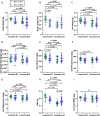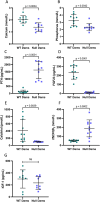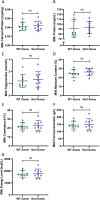Loss of maternal calcitriol reversibly alters early offspring growth and skeletal development in mice
- PMID: 38477809
- PMCID: PMC11206081
- DOI: 10.1093/jbmr/zjae035
Loss of maternal calcitriol reversibly alters early offspring growth and skeletal development in mice
Abstract
Ablation of Cyp27b1 eliminates calcitriol but does not disturb fetal mineral homeostasis or skeletal development. However, independent of fetal genotypes, maternal loss of Cyp27b1 altered fetal mineral and hormonal levels compared to offspring of WT dams. We hypothesized that these maternal influences would alter postnatal skeletal development. Cyp27b1 null and WT females were mated to bear only Cyp27b1+/- offspring. Forty-eight hours after birth, pups were cross-fostered to dams of the same or opposite genotype that bore them. Maternal and offspring samples were collected on days 21 (weaning) and 42. Offspring measurements included minerals and hormones, BMC by DXA, ash weight and mineral content, gene expression, 3-point bending tests, and microCT. Maternal lactational behavior was evaluated. Milk was analyzed for nutritional content. At day 21, offspring fostered by nulls, independent of birth dam, had ~20% lower weight, BMC, ash weight, and ash calcium than pups fostered by WT dams. Adjustment for body weight accounted for the lower BMC but not the lower ash weight and ash calcium. Hormones and serum/urine minerals did not differ across offspring groups. Offspring fostered by nulls had shorter femurs and lower cortical thickness, mean polar moment of inertia, cortical area, trabecular bone volume, and trabecular number. Dam lactational behaviors and milk nutritional content did not differ between groups. At day 42, body weight, ash weight, lengths, BMC, and tibial bone strength were no longer different between pups fostered by null vs WT dams. In summary, pups fostered by Cyp27b1 nulls, regardless of birth dam, have proportionately smaller skeletons at 21 d, impaired microstructure, but normal mineral homeostasis. The skeletal effects are largely recovered by day 42 (3 wk after weaning). In conclusion, maternal loss of calcitriol impairs early postnatal cortical bone growth and trabecular bone mass, but affected offspring catch up after weaning.
Keywords: 1α-hydroxylase; Cyp27b1; calcitriol; calcium; mineralization; neonate; parathyroid hormone; phosphorus; skeleton.
© The Author(s) 2024. Published by Oxford University Press on behalf of the American Society for Bone and Mineral Research.
Conflict of interest statement
None declared.
Figures










Similar articles
-
Absence of Calcitriol Causes Increased Lactational Bone Loss and Lower Milk Calcium but Does Not Impair Post-lactation Bone Recovery in Cyp27b1 Null Mice.J Bone Miner Res. 2018 Jan;33(1):16-26. doi: 10.1002/jbmr.3217. Epub 2017 Aug 2. J Bone Miner Res. 2018. PMID: 28686309
-
Maternal loss of 24-hydroxylase causes increased intestinal calcium absorption and hypercalcemia during pregnancy but reduced skeletal resorption during lactation in mice.J Bone Miner Res. 2024 Nov 29;39(12):1793-1808. doi: 10.1093/jbmr/zjae166. J Bone Miner Res. 2024. PMID: 39385466 Free PMC article.
-
Upregulation of calcitriol during pregnancy and skeletal recovery after lactation do not require parathyroid hormone.J Bone Miner Res. 2013 Sep;28(9):1987-2000. doi: 10.1002/jbmr.1925. J Bone Miner Res. 2013. PMID: 23505097
-
Mineral Homeostasis in Murine Fetuses Is Sensitive to Maternal Calcitriol but Not to Absence of Fetal Calcitriol.J Bone Miner Res. 2019 Apr;34(4):669-680. doi: 10.1002/jbmr.3642. Epub 2019 Jan 2. J Bone Miner Res. 2019. PMID: 30508318
-
Calcium and Phosphate Metabolism and Related Disorders During Pregnancy and Lactation.2024 Oct 12. In: Feingold KR, Ahmed SF, Anawalt B, Blackman MR, Boyce A, Chrousos G, Corpas E, de Herder WW, Dhatariya K, Dungan K, Hofland J, Kalra S, Kaltsas G, Kapoor N, Koch C, Kopp P, Korbonits M, Kovacs CS, Kuohung W, Laferrère B, Levy M, McGee EA, McLachlan R, Muzumdar R, Purnell J, Rey R, Sahay R, Shah AS, Singer F, Sperling MA, Stratakis CA, Trence DL, Wilson DP, editors. Endotext [Internet]. South Dartmouth (MA): MDText.com, Inc.; 2000–. 2024 Oct 12. In: Feingold KR, Ahmed SF, Anawalt B, Blackman MR, Boyce A, Chrousos G, Corpas E, de Herder WW, Dhatariya K, Dungan K, Hofland J, Kalra S, Kaltsas G, Kapoor N, Koch C, Kopp P, Korbonits M, Kovacs CS, Kuohung W, Laferrère B, Levy M, McGee EA, McLachlan R, Muzumdar R, Purnell J, Rey R, Sahay R, Shah AS, Singer F, Sperling MA, Stratakis CA, Trence DL, Wilson DP, editors. Endotext [Internet]. South Dartmouth (MA): MDText.com, Inc.; 2000–. PMID: 25905396 Free Books & Documents. Review.
Cited by
-
Bone mineral density deficits in individuals born preterm persist through young adulthood: A systematic review and meta-analysis of DXA studies.Bone. 2025 Sep;198:117519. doi: 10.1016/j.bone.2025.117519. Epub 2025 May 17. Bone. 2025. PMID: 40389187 Review.
References
-
- Bikle D, Adams J, Christakos S. Vitamin D: production, metabolism, mechanism of action, and clinical requirements. In: Rosen CJ, ed. Primer on the Metabolic Bone Diseases and Disorders of Mineral Metabolism, 8th ed. Ames, IA: Wiley-Blackwell; 2013:235–247 10.1002/9781118453926.ch29 - DOI
-
- O'Callaghan KM, Hennessy A, Hull GLJ, et al. . Estimation of the maternal vitamin D intake that maintains circulating 25-hydroxyvitamin D in late gestation at a concentration sufficient to keep umbilical cord sera >/=25-30 nmol/L: a dose-response, double-blind, randomized placebo-controlled trial in pregnant women at northern latitude. Am J Clin Nutr. 2018;108(1):77–91. 10.1093/ajcn/nqy064 - DOI - PMC - PubMed
MeSH terms
Substances
Grants and funding
LinkOut - more resources
Full Text Sources
Research Materials
Miscellaneous

